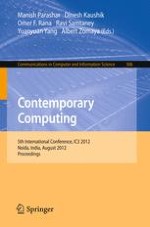2012 | Book
Contemporary Computing
5th International Conference, IC3 2012, Noida, India, August 6-8, 2012. Proceedings
Editors: Manish Parashar, Dinesh Kaushik, Omer F. Rana, Ravi Samtaney, Yuanyuan Yang, Albert Zomaya
Publisher: Springer Berlin Heidelberg
Book Series : Communications in Computer and Information Science
